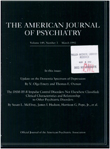The hypothalamic-pituitary-thyroid axis in social phobia
Abstract
The authors investigated indices of hypothalamic-pituitary-thyroid (HPT) axis function in patients with social phobia. They found no differences between patients with social phobia and age- and sex- matched control subjects in plasma T3, T4, free T4, or TSH levels or in the proportion of subjects with positive antithyroid antibodies. Patients with social phobia and control subjects also did not differ in three of the four measures used to assess TSH response to TRH. These data suggest that abnormalities in thyroid function are not requisite neuroendocrine correlates of social phobia.
Access content
To read the fulltext, please use one of the options below to sign in or purchase access.- Personal login
- Institutional Login
- Sign in via OpenAthens
- Register for access
-
Please login/register if you wish to pair your device and check access availability.
Not a subscriber?
PsychiatryOnline subscription options offer access to the DSM-5 library, books, journals, CME, and patient resources. This all-in-one virtual library provides psychiatrists and mental health professionals with key resources for diagnosis, treatment, research, and professional development.
Need more help? PsychiatryOnline Customer Service may be reached by emailing [email protected] or by calling 800-368-5777 (in the U.S.) or 703-907-7322 (outside the U.S.).



